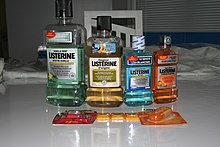
Back غسول الفم Arabic Col·lutori bucal Catalan Gò̤-dâung-chói cūi CDO Ústní voda Czech Mundspüllösung German Στοματικό διάλυμα Greek Buŝlavo Esperanto Enjuague bucal Spanish Kolutorio Basque Suuvesi Finnish

Mouthwash, mouth rinse, oral rinse, or mouth bath[1] is a liquid which is held in the mouth passively or swirled around the mouth by contraction of the perioral muscles and/or movement of the head, and may be gargled, where the head is tilted back and the liquid bubbled at the back of the mouth.
Usually mouthwashes are antiseptic solutions intended to reduce the microbial load in the mouth, although other mouthwashes might be given for other reasons such as for their analgesic, anti-inflammatory or anti-fungal action. Additionally, some rinses act as saliva substitutes to neutralize acid and keep the mouth moist in xerostomia (dry mouth).[2][3] Cosmetic mouthrinses temporarily control or reduce bad breath and leave the mouth with a pleasant taste.[4]
Rinsing with water or mouthwash after brushing with a fluoride toothpaste can reduce the availability of salivary fluoride. This can lower the anti-cavity re-mineralization and antibacterial effects of fluoride.[5][6][7] Fluoridated mouthwash may mitigate this effect or in high concentrations increase available fluoride, but is not as cost-effective as leaving the fluoride toothpaste on the teeth after brushing.[5] A group of experts discussing post brushing rinsing in 2012 found that although there was clear guidance given in many public health advice publications to "spit, avoid rinsing with water/excessive rinsing with water"[8] they believed there was a limited evidence base for best practice.[9]
- ^ Matthews RW (July 2003). "Hot salt water mouth baths". British Dental Journal. 195 (1): 3. doi:10.1038/sj.bdj.4810318. PMID 12856008. S2CID 3995032.
- ^ Reddy S (12 January 2015). "There is More to Your Mouthwash Than a Minty Taste". The Wall Street Journal.
- ^ Tufts University (23 March 2015). "Should I use mouthwash?". Medical Xpress.
- ^ "Learn More About Mouthrinses". American Dental Association. Archived from the original on 11 October 2014.
- ^ a b Mystikos C, Yoshino T, Ramberg P, Birkhed D (2011). "Effect of post-brushing mouthrinse solutions on salivary fluoride retention". Swedish Dental Journal. 35 (1): 17–24. PMID 21591596.
- ^ Chesters RK, Huntington E, Burchell CK, Stephen KW (1992). "Effect of oral care habits on caries in adolescents". Caries Research. 26 (4): 299–304. doi:10.1159/000261456. PMID 1423447.
- ^ Zamataro CB, Tenuta LM, Cury JA (June 2008). "Low-fluoride dentifrice and the effect of postbrushing rinsing on fluoride availability in saliva". European Archives of Paediatric Dentistry. 9 (2): 90–3. doi:10.1007/BF03262616. PMID 18534177. S2CID 31708112.
- ^ "Delivering better oral health: an evidence-based toolkit for prevention" (PDF) (3rd ed.). Public Health England, Department of Health. March 2017.
- ^ Pitts N, Duckworth RM, Marsh P, Mutti B, Parnell C, Zero D (April 2012). "Post-brushing rinsing for the control of dental caries: exploration of the available evidence to establish what advice we should give our patients". British Dental Journal. 212 (7): 315–20. doi:10.1038/sj.bdj.2012.260. PMID 22498529.